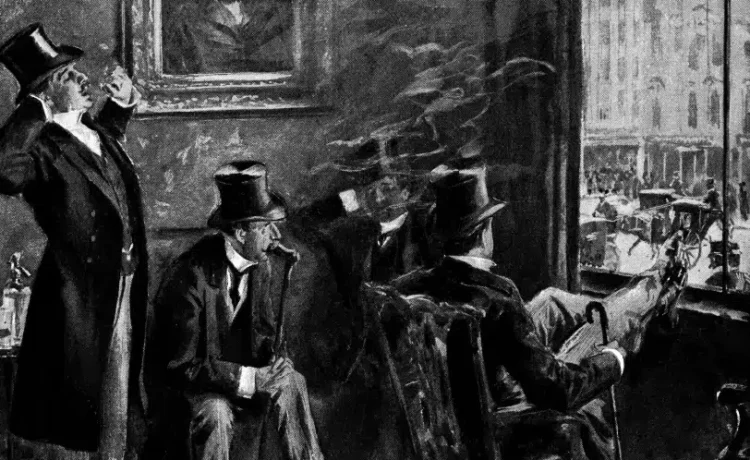
 In New York private social clubs for men were modeled after the clubs in London, which date back to the late 1600s and early 1700s. Men could dine, read the papers, take part in entertainments such as card games or bowling, and build social networks.
In New York private social clubs for men were modeled after the clubs in London, which date back to the late 1600s and early 1700s. Men could dine, read the papers, take part in entertainments such as card games or bowling, and build social networks.
There were strict membership rules and most private clubs were only open to elite white Christian men. Some allowed limited dining access to member-accompanied white Christian wives or widows.
Some early “gentleman’s clubs” provided access to illegal gambling inspiring the term “casino,” which comes from an Italian word for “little home.” Despite this tendency, men’s clubs adhered to rules of etiquette.
“Having been elected, members must make it their business to study the rules and regulations of the club, and rigidly observe them,” according to Etiquette for Gentlemen (1929).
“The man who monopolizes the best chair in the place nearest the fire, and appropriates an undue share of the most up-to-date paper, is never popular.
“The new member should be ready to give up his chair to an older member or an older man, to co-operate with his fellow members in their common interests, and to behave as courteously and kindly to them as if they were fellow guests in a friend’s house.”
In the United States clubs were founded first in the major cities such as New York, Boston and Philadelphia. Among the oldest in New York was the Union Club, founded in the city of New York in 1836.
(Other notable clubs in the city were the Knickerbocker Club, founded in 1871 by former members of the Union Club, and the Metropolitan Club, founded by J.P. Morgan in 1891.)
These gentleman’s clubs also flourished in several upstate New York cities. Many of the clubs owned large ornate buildings that were elaborately furnished.
Most contained a bar, dining room, reading rooms, a library, and game rooms. Some offered sleeping rooms.
Although many declined after World War Two among the changing social norms, a few have modernized and are still active today.
The Troy Club (no longer operating) was founded in 1867 by a group of wealthy men on Congress at First Street in Troy, NY.
There were several membership categories: Resident (men who lived within 25 miles); Non-resident (men who lived beyond 25 miles); Junior (men under 30); Corporate (some companies could have one resident membership, and two non-resident memberships).
The club provided a personal, friendly atmosphere, with a large dining room on the second floor. The menus were often elaborate, including Lobster Newburg, Vichyssoise, and Lamb Chops with mint jelly.
Weekly poker and gin-rummy games were played in the club’s card room, and there was bowling available as well.
The Troy Club hosted an annual Lincoln’s Birthday Dinner in February. There was also Caribbean Night, German Night, and a St. Patrick’s Day celebration. New Years Eve was the traditional time to sign the membership roll for the next year.
At the Troy Club women were only allowed in the dining room and ballroom and had to enter and leave through a small back door and back stairway.
The Troy Club did not last, as two fires sealed its fate. It first burned on December 30, 1903, and another fire in 1981 completely destroyed the club.
Three men lost their lives in the 1903 fire, which was reported across the state and as far as California: Troy lawyers Moses T. Clough, age 90, and William Shaw, plus Benjamin W. Kinney of Boston. They had all been sleeping on the third floor when the fire broke out.

 Fort Orange Club in Albany
Fort Orange Club in Albany
The Fort Orange Club began in 1880 on Washington Avenue in Albany, NY and is still operating today at the same location. Members have included numerous New York governors, state and national officials, and prominent businessmen such as Erastus Corning Jr. (the club’s first president), Robert H. Pruyn (Albany lawyer and politician), and Daniel Manning (president of the Albany Argus).
The Club, housed in a former mansion in which Aaron Burr once lived, was originally limited to 200 members who were residents of Albany.
The charter members were from the city’s elites in manufacturing, attorneys, bankers, publishers and those in government. Although it was an exclusive club for men, women were invited to attend some events.
In January 1881, the club hosted ex-President Ulysses S. Grant and in 1955 representatives from seven NATO countries dined at Club.
According to Fort Orange Club: The first 125 Yrs, 1880-2005 by Diana S. Waite, Governor Alfred E. Smith was a frequent visitor during the 1920s. A swimming pool and athletic wing were built in 1929.
Membership declined during the Great Depression but rebounded in the 1950s when membership was opened to those who lived outside.
Women were finally allowed to be members in 1989. Elizabeth Platt Corning, widow of Erastus Corning II, was among the first women members.

 Fort Schuyler Club in Utica
Fort Schuyler Club in Utica
Founded in 1883 Fort Schuyler Club on Genesee Street in Utica, NY was originally for business and professional men. Its constitution stated that “any person [man] of reputable character over the age of twenty- one years” was welcome.
Membership categories included Executive: age 40+, Intermediate: age 34-39, Junior A: age 23-33, and Junior B: age 21-27. It wasn’t until 1981 that women were finally admitted.
According to the website, today the club embraces all races, creeds, colors, religions, places of origin, sexual orientation, and people with disabilities.
The main activities in the early years were networking, dining, social events, and games
such as billiards.
In September 1884 people gathered at the club to toast Galina Vishnevskaya, a renowned soprano who had just published Galina: A Russian Story.
“Probably no one was thinking somber thoughts about freedom vs. oppression at the reception,” the Sunday Observer Dispatch reported.
“They were celebrating the very circumstances that brought their honored guest to this country… In attendance were people…from all walks of life, Republicans, Democrats and Independents representing many different interests and views.”
Another popular activity was smoking, as over $2,000 was spent on cigars in 1930 according to the club, which is on the State and National Register of Historic Places.

 The Century Club in Syracuse
The Century Club in Syracuse
Syracuse‘s Century Club was founded in 1866 as an association for literary and recreational purposes. First called The Onondaga Club, it became the Century Club in 1876.
Prominent early members included Dr. Willis H. Carrier (Carrier Corporation), Huntington B. Crouse (Crouse-Hinds Corporation), and Frederick R. Hazard (Solvay Process). Several members served on the New York State Court of Appeals.
In 1906 bowling alleys were added to the rear of the clubhouse and in 1909, decorative improvements were made to a part of the clubhouse for the comfort of members’ wives.
“It is only recently that the gentler sex has been allowed in this ‘sanctum sanctorum’ of the men,” the Syracuse Herald-Journal observed at the time.
Illustrations, from above: A 19th century view inside of a New York gentleman’s club; The Troy Club, from Troy ‘s One Hundred Years 1789-1889 (1891); the Fort Orange Club before renovations (from an old postcard); Dinner the Oak Room at the Fort Schuyler Club (provided); and The Century Club of Syracuse.









Recent Comments